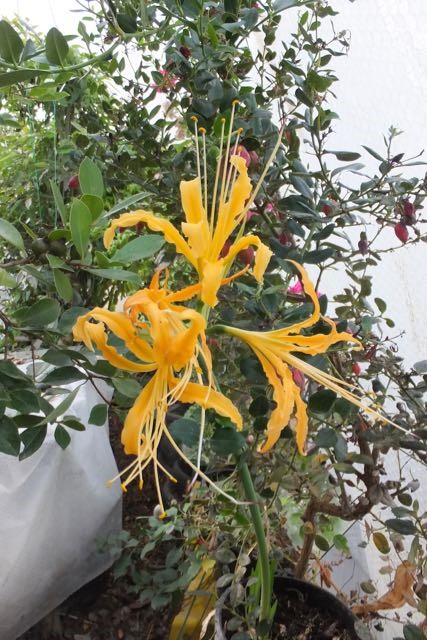
To grow this really pretty bloom year after year you want a warm greenhouse or conservatory as it is tender. (Though to be fair some have succeeded for a while in sheltered sites outdoors.) Long loved in China and Japan the first Golden Spider lily bulbs arrived in the seventeen hundreds on the clipper ships along with tea and pottery. With an impressive flower these bulbous plants soon became popular in the new glass houses.
The bulbs first produce long pendant strap like leaves in spring then at the end of summer as these die down throw spikes of glorious flowers. These are in bright yellows or reds, welcome colour in autumn and even on into winter.
Not one of the true Lily genus the Golden Spider lily is actually in the Amaryllis family with the Belladonna lily and the Nerines from Africa. The Latin name is misleading, most Lyco names infer a wolf. The Golden Spider lily was originally classed as Amaryllis then Nerine before it became Lycoris, named after the beautiful, intriguing, mistress of Mark Anthony.
The Golden Spider lily needs to become quite a large bulb before it will start to flower so although it’s possible to start with seed it makes sense to purchase big bulbs ready grown and to then multiply by offsets if many are wanted.
A large pot or small tub of leaf-mould rich compost is required, best mixed fifty fifty with sharp sand to ensure free drainage. Ideally plant new bulbs in summer or early autumn. Do not bury the bulb but set it half into the surface so the neck is proud. The bulbs require careful, regular watering, with a little liquid feed occasionally, throughout the growing season.
The bulbs then rest in winter after flowering and until they start into leaf again late spring or early summer. During that period the bulbs need to be in nearly dry compost, and to ripen better is why their necks need to be exposed to the air.
As long as growing in a warm and sunny but not scorching bright position these are problem free seldom suffering pests or disease.
Enthusiasts can find up to ten species and varieties, all originating from China and Japan, in reds, oranges and yellows, and some even have scent.


